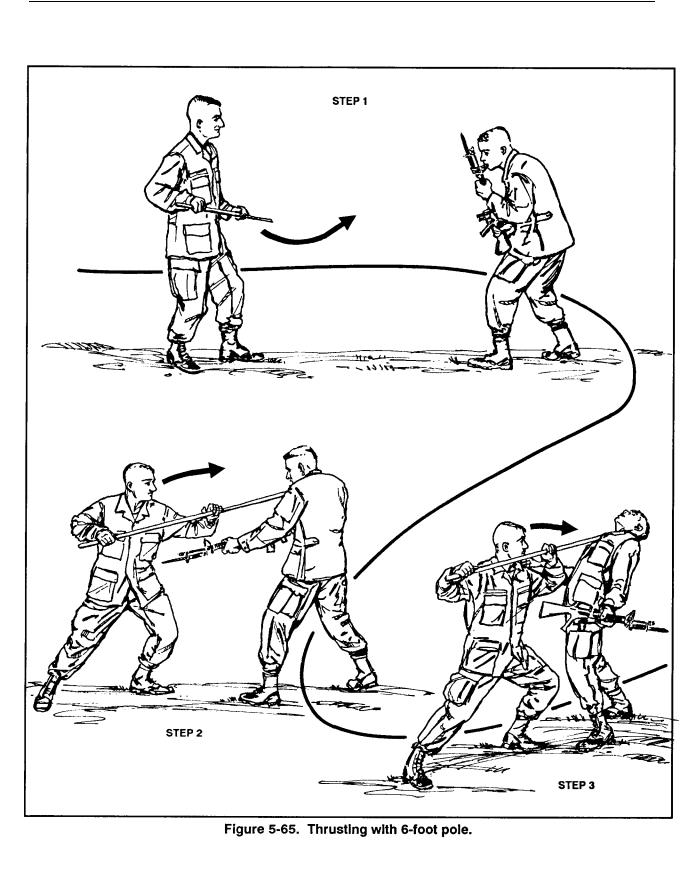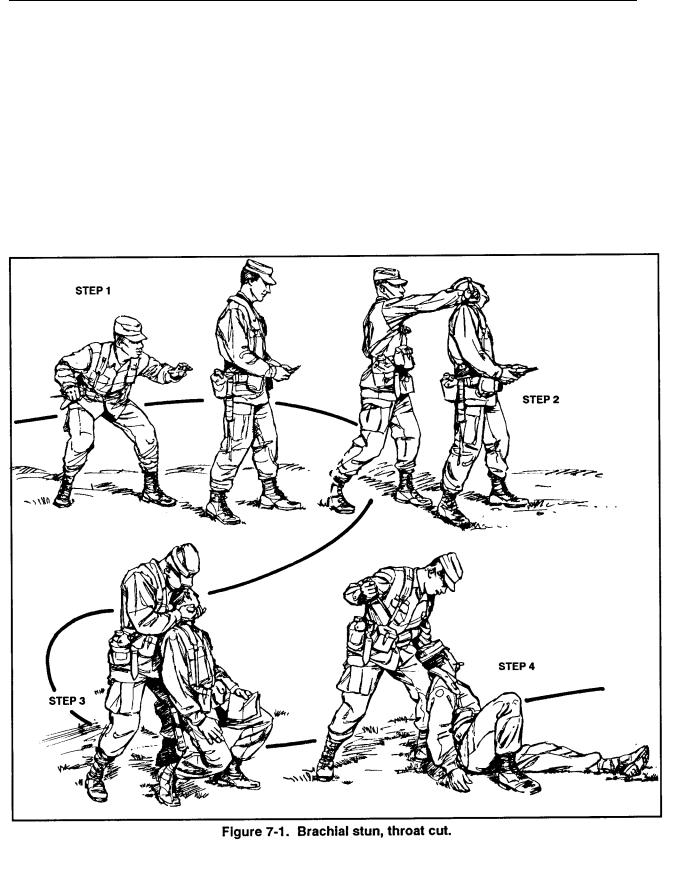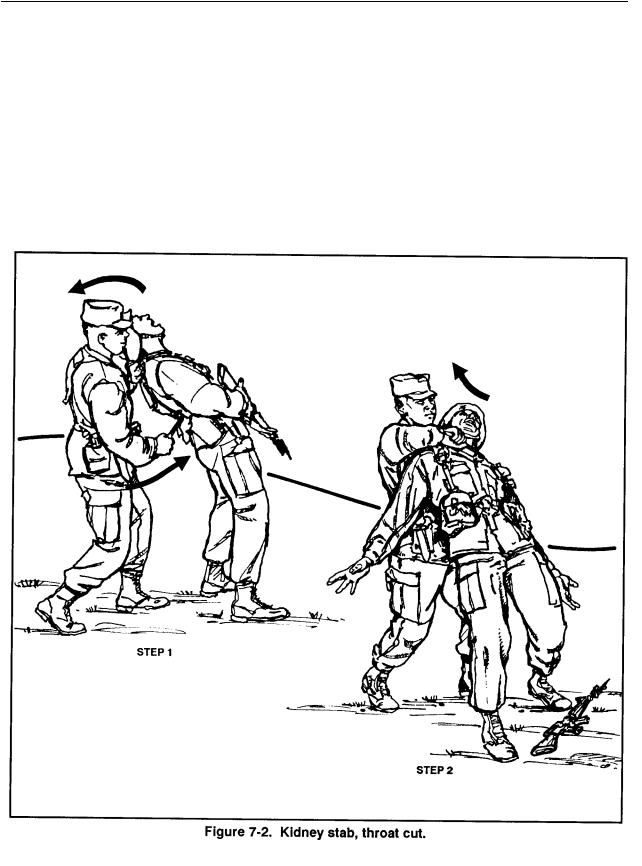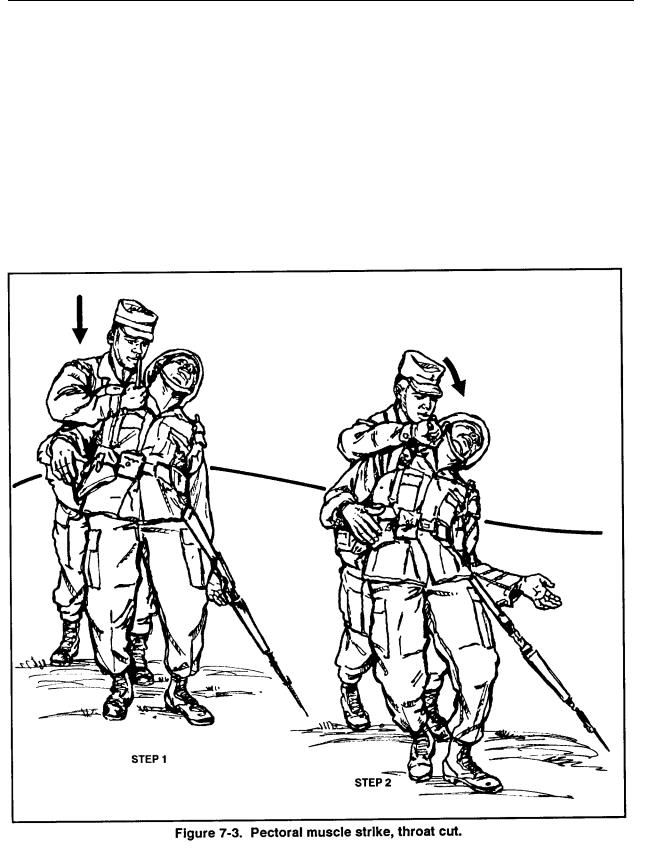
FM 21-150 COMBATIVES 1992
.pdf
FM 21-150
5-14. SIX-FOOT POLE
Another field-expedient weapon that can mean the difference between life and death for a soldier in an unarmed conflict is a pole about 6 feet long. Examples of poles suitable for use are mop handles, pry bars, track tools, tent poles, and small trees or limbs cut to form a pole. A soldier skilled in the use of a pole as a weapon is a formidable opponent. The size and weight of the pole requires him to move his whole body to use it effectively. Its length gives the soldier an advantage of distance in most unarmed situations. There are two methods usually used in striking with a pole:
a.Swinging. Becoming effective in swinging the pole requires skilled body movement and practice. The greatest power is developed by striking with the last 2 inches of the pole.
b.Thrusting. The pole is thrust straight along its axis with the user’s body mass firmly behind it.
(1)An attacker tries to thrust forward with a fixed bayonet (Figure 5-65, Step 1).
The defender moves his body off the line of attack; he holds the tip of the pole so that the attacker runs into it from his own momentum. He then aims for the jugular notch and anchors his body firmly in place so that the full force of the attack is felt at the attacker’s throat (Figure 5-65, Step 2).
(2) The defender then shifts his entire body weight forward over his lead foot and drives the attacker off his feet (Figure 5-65, Step 3).
NOTE: During high stress, small targets, such as the throat, may be difficult to hit. Good, large targets include the solar plexus and hip/thigh joint.
5-98

FM 21-150
5-99
CHAPTER 6
TRANSITION TECHNIQUES
In battle, when a combat soldier closes with the enemy to within small-arms and grenade range, and he has exhausted his ammunition or his weapon fails to fire, the fluidity of the battle may dictate that he will become engaged in hand-to-hand combat.
6-1. COMBAT SCENARIOS
In some combat scenarios, innocent noncombatants may be present. Firing of small arms, grenades, and so on, would needlessly endanger them. Therefore, the soldier may need to engage the enemy in hand-to-hand combat in such situations. In other scenarios, the enemy may make a surprise attack at close quarters or confront the soldier in an area where firearms are either out of reach or impractical to use.
6-2. BRIDGING THE GAP BETWEEN RANGES
An imaginary sphere of defense extends all-round a soldier and spans the length of his arms. In hand-to-hand combat, the space and distance between opponents, known as the interval gap, is the primary factor in the soldier’s ability to interpret and react to the enemy’s movement. Within the interval gap is a zone of safety, the reactionary gap, which allows time for the soldier’s reaction to the enemy’s movement.
a.The average reactionary gap to an unarmed attacker is 6 feet—that is, the zone of safety that allows him time to observe and to react to an attack from an unarmed opponent. The average reactionary gap to an attacker armed with a weapon is 10 feet, plus the length of the weapon.
b.A soldier must be able to maintain constant control of his sphere of defense by interpreting the timing and rhythm of the enemy’s movements and the interval gap during the attack. Having control gives him an opportunity
to bridge the gap and enter the enemy’s sphere of defense at will.Timing and
distance are the keys to controlling the situation.
6-1

FM 21-150
c. In hand-to-hand combat, an attacking enemy has only one intent—to kill his opponent. To survive, the combat soldier must not allow the enemy to penetrate his sphere of defense. He must stay mentally alert and be aware of an all-round perimeter of defense. He must visualize the nine basic angles of attack. His best reaction to the enemy is to strike first or counterattack before the enemy has a chance to develop his offensive. Surprise increases the chances of success. The soldier must be physically mobile, react to the enemy’s movement with the proper response, and counterattack according to the enemy’s rhythm, timing, and distance. He must also control the tempo of the fight with consecutive and successful attacks, seizing the momentum and winning. A memory aid is, “Win or Die!”
d. When the enemy bridges the soldier’s interval gap, the soldier must defend his personal perimeter. He has six options.
(1)Avoid the attack. This option calls for the soldier to disengage by increasing the separation and by staying out of range.
(a) He can retreat to influence the enemy to pursue, then counterattack when his position is more favorable.
(b) He can move his body out of the line of attack of the enemy or his weapon. A simple, economical, and effective reaction to a straight-line attack is to sidestep off the angle of attack at a 45-degree angle. Then, the soldier can penetrate the enemy’s sphere of defense at an offset angle. He is now in a position where he is both safe and strong, but the enemy’s vital targets are exposed and his balance is weakened.
(2)Lead the force of the attack. This option involves receiving the enemy’s attack and making him extend or travel farther than he intended. To take control of the attack, the soldier uses his own weight and body mass and the enemy’s onrushing weight to cause the enemy to lose his balance.
(3)Redirect the force. The soldier changes the enemy’s direction of attack by directing it off its original line or angle. This causes openings in the
enemy’s defense so the soldier can counterattack.
(4)Absorb the force. In this option, the soldier receives the enemy attack, but he absorbs the impact so that the effect is harmless. The enemy is deceived into thinking his attack is successful, and his momentary lapse in defense allows the soldier to react with the right counterattack.
(5)Meet force with force. The soldier can meet the incoming attack and burst through the enemy’s defense by sheer brute force. When using this option, an effective reaction is to step off the line of attack just enough to avoid being struck and meet the enemy with a suitable body weapon (or other weapon if available). The two forces meet with combined body masses in motion, but the enemy is damaged. A superior mental attitude (the will to survive) is essential for the soldier to accomplish this option.
6-2

FM 21-150
(6) Use the momentum of the force against the attacker. With this option, the hand-to-hand fighter uses the attacker’s momentum against him to gain control of his balance or to expose weaknesses in his defense. The soldier can add his own force to that of the attacker to increase the power and damage effect.
e. A soldier must develop the intuitive ability to change counterattack techniques according to his range from the enemy—that is, long, medium, or close range. He is then more likely to sense weaknesses in the defensive sphere of his opponent and to respond instinctively with the most effective body movement and weapon for the range—moment by moment. The soldier using any of these six options, or combinations of them, to react to an attack with proper timing and distance, as well as swift counterattack will emerge victorious in a hand-to-hand confrontation.
6-3
CHAPTER 7
SENTRY REMOVAL
Careful planning rehearsal, and execution are vital to the success of a mission that requires the removal of a sentry. This task may be necessary to gain access to an enemy location or to escape confinement.
7-1. PLANNING CONSIDERATIONS
A detailed schematic of the layout of the area guarded by sentries must be available. Mark known and suspected locations of all sentries. It will be necessary—
a.To learn the schedule for the changing of the guards and the checking of the posts.
b.To learn the guard’s meal times. It may be best to attack a sentry soon after he has eaten when his guard is lowered. Another good time to attack the sentry is when he is going to the latrine.
c.To post continuous security.
d.To develop a contingency plan.
e.To plan infiltration and exfiltration routes.
f.To carefully select personnel to accomplish the task.
g.To carry the least equipment necessary to accomplish the mission because silence, stealth, and ease of movement are essential.
h.To conceal or dispose of killed sentries.
7-2. REHEARSALS
Reproduce and rehearse the scenario of the mission as closely as possible to the execution phase. Conduct the rehearsal on similar terrain, using sentries, the time schedule, and the contingency plan. Use all possible infiltration and exfiltration routes to determine which may be the best.
7-3. EXECUTION
When removing a sentry, the soldier uses his stalking skills to approach the enemy undetected. He must use all available concealment and keep his silhouette as low as possible.
7-1

FM 21-150
a. When stepping, the soldier places the ball of his lead foot down first and checks for stability and silence of the surface to be crossed. He then lightly touches the heel of his lead foot. Next, he transfers his body weight to his lead foot by shifting his body forward in a relaxed manner. With the weight on the lead foot, he can bring his rear foot forward in a similar manner.
b. When approaching the sentry, the soldier synchronizes his steps and movement with the enemy’s, masking any sounds. He also uses background noises to mask his sounds. He can even follow the sentry through locked doors this way. He is always ready to strike immediately if he is discovered. He focuses his attention on the sentry’s head since that is where the sentry generates all of his movement and attention. However, it is important not to stare at the enemy because he may sense the stalker’s presence through a sixth sense. He focuses on the sentry’s movements with his peripheral vision. He gets to within 3 or 4 feet and at the proper moment makes the kill as quickly and silently as possible.
c. The attacker’s primary focus is to summon all of his mental and physical power to suddenly explode onto the target. He maintains an attitude of complete confidence throughout the execution. He must control fear and hesitation because one instant of hesitation could cause his defeat and compromise the entire mission.
7-4. PSYCHOLOGICAL ASPECTS
Killing a sentry is completely different than killing an enemy soldier while engaged in a firefight. It is a cold and calculated attack on a specific target. After observing a sentry for hours, watching him eat or look at his wife’s photo, an attachment is made between the stalker and the sentry. Nonetheless, the stalker must accomplish his task efficiently and brutally. At such close quarters, the soldier literally feels the sentry fight for his life. The sights, sounds, and smells of this act are imprinted in the soldier’s mind; it is an intensely personal experience. A soldier who has removed a sentry should be observed for signs of unusual behavior for four to seven days after the act.
7-5. TECHNIQUES
The following techniques are proven and effective ways to remove sentries. A soldier with moderate training can execute the proper technique for his situation, when he needs to.
a. Brachial Stun, Throat Cut. This technique relies on complete mental stunning to enable the soldier to cut the sentry’s throat, severing the trachea and carotid arteries. Death results within 5 to 20 seconds. Some sounds are emitted from the exposed trachea, but the throat can be cut before the sentry can recover from the effect of the stunning strike and cry out. The soldier
7-2

FM 21-150
silently approaches to within striking range of the sentry (Figure 7-1, Step 1). The soldier strikes the side of the sentry’s neck with the knife butt or a hammer fist strike (Figure 7-1, Step 2), which completely stuns the sentry for three to seven seconds. He then uses his body weight to direct the sentry’s body to sink in one direction and uses his other hand to twist the sentry’s head to the side, deeply cutting the throat across the front in the opposite direction (Figure 7-1, Step 3). He executes the entire length of the blade in a slicing motion. The sentry’s sinking body provides most of the force—not the soldier’s upper-arm strength (Figure 7-1, Step 4).
7-3

FM 21-150
b. Kidney Stab, Throat Cut. This technique relies on a stab to the kidney (Figure 7-2, Step 1) to induce immediate shock. The kidney is relatively accessible and by inducing shock with such a stab, the soldier has the time to cut the sentry’s throat. The soldier completes his stalk and stabs the kidney by pulling the sentry’s balance backward and downward and inserts the knife upward against his weight. The sentry will possibly gasp at this point, but shock immediately follows. By using the sentry’s body weight that is falling downward and turning, the soldier executes a cut across the front of the throat (Figure 7-2, Step 2). This completely severs the trachea and carotid arteries.
7-4

FM 21-150
c. Pectoral Muscle Strike, Throat Cut. The stun in this technique is produced by a vigorous strike to the stellate ganglia nerve center at the top of the pectoral muscle (Figure 7-3, Step 1). The strike is delivered downward with the attacker’s body weight. Use the handle of the knife for impact. Care should be taken to avoid any equipment worn by the sentry that could obstruct the strike. Do not try this technique if the sentry is wearing a ballistic vest or bulky LCE. The sentry is unable to make a sound or move if the stun is properly delivered. The throat is then cut with a vertical stab downward into the subclavian artery at the junction of the neck and clavicle (Figure 7-3, Step 2). Death comes within 3 to 10 seconds, and the sentry is lowered to the ground.
7-5
